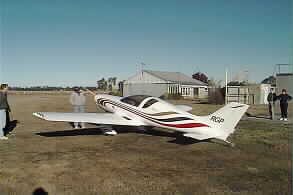
Jabiru Pulasr by Graham Palmer
|
My Jabiru powered Pulsar has attracted a lot of interested people. It's the first Pulsar in NZ powered with this engine. Apart from a builder in Greece it's the only other series 11 outside of the US. And the only one to be configured to a taildragger. My Aero Designs series 11 Pulsar was shipped from the Aero Designs factory in San Antonio Texas. On the 18 Sept I received a invoice for kit serial #509 and the conformation that the kit was on it's way. |
My wife and I departed to Australia on the 9 August to go visit the Jabiru factory (and the gold coast) I was very interested in seeking more information about this aircraft engine. After visiting the Jabiru factory I was absolutely sure that this was the engine for my Pulsar. The factory had just completed the very first of type Jabiru 2.2 engine fitting in a Pulsar airframe to FAR 23 standards witnessed and approved by Australian Civil Aviation Safety Authority.
I contacted NZ CAA and took reservation on registration mark ZK-RGP. About the same time a letter arrived with news that Aero Designs had sold it's designs rights to Skystar Aircraft Corporation. My kit # 509 was the second to last out A/D door. Made in batches of ten, eight of the series 11 kits were sold in the States the other one to leave the US went to a builder in Greece. The Kit arrived and finally made it's way to my garrage on the 3 NOV 96. Nothing was able to happen until the 28- 05- 96 When Skystar came to the rescue with a set of A/D building manuals. They were later to send there own revised set of building manuals as well as missing kit parts.
The firewall aft kit comprised glass molded half shells and hardware, epoxy pump, glass cloth, full set of Cleveland wheels and brakes, AN hardware, seat belts etc. Jabiru New Zealand supplied the 2.2 engine and FWF kit. This comprises every thing required forward of the fire wall. Engine truss mounts, Carb heat box, Prop, full electrical, glass cowls and attachment fittings, electric fuel boost pump, muffler, engine instruments etc.
I enjoyed working with glass and apart from the hassles with missing parts, Two LH flaps, and no information on fitting out a taildragger, things went quite well during the construction. At times I also reminded my self that it's not the smartest thing to be first in doing something different. This in relation to fitting an alternate engine.
When I started out with this project I was advised by a NZ Pulsar builder to register the Pulsar in the micro light class. That was fine and good advice as it saved heaps of dollars and with less hassles. However in this country o take that track with a aeroplane that's that far away from what's excepted normal for a micro light it was necessary to work through the Canadian TP10141E system. To make what I am saying a little easer to understand the Pulsar and all aircraft in the 1200 LBS group are, in Canada, legal as a micro lights. And as the NZ CAA have adopted the Canada, in recreational aviation, system it's able to registered here as a micro light. However things like changing engines requires the OK from the manufacture to fit an alternate engine.This took some effort in spite of being assured at the time of ordering that this had been all fixed!
 |
ZK-RGP has an empty weight of 575 LBS and maximum all up weight of 1200 LBS. I conducted a twenty minute test flight on Friday 9 July '99. At this stage the speeds are only indicated. (Yet to have the GPS hooked up) At full throttle with a engine that's still very tight in level flight I am pulling 2650 RPM and showing 142 KTS. Full throttle climb at 70 KTS its showing 1400 FPM with one up and full tanks. |
As of now ZK-RGP has done 6.4 HRS flying and is a delight to fly.